When bodybuilders consider the nuts and bolts of nutrition, two of the most critical issues they have to wrestle with are how much protein to consume and what sources to rely on.
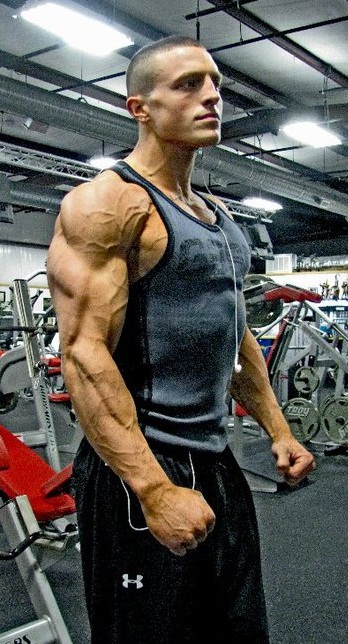 We recommend taking in at least one gram (g) of protein per pound of bodyweight every day. In a cutting phase, the amount should be bumped up to at least 1 1/4 g of protein per pound of bodyweight, but total calories should be slashed, primarily by reducing carbs. So, the answer to “how much” is fairly straightforward. Zeroing in on the right protein sources, however, is more complicated.
We recommend taking in at least one gram (g) of protein per pound of bodyweight every day. In a cutting phase, the amount should be bumped up to at least 1 1/4 g of protein per pound of bodyweight, but total calories should be slashed, primarily by reducing carbs. So, the answer to “how much” is fairly straightforward. Zeroing in on the right protein sources, however, is more complicated.
The Protein Factor
When your aim is to get shredded, you must cut calories, but you also need plenty of protein to make sure your body doesn’t start catabolizing (tearing down) hard-earned muscle tissue. Choosing foods that are very high in protein is the best strategy.
When you’re trying to get your muscles to grow as much as possible, calories are critical, as are the amino acids (derived from protein foods) required for muscle construction. The percent of calories that should come from protein depends on your bodytype and genetics. Bodybuilders who tend to add excess fat as they add muscle mass should choose foods that have a higher percentage of protein calories.
Hardgainers need more calories overall for muscle growth and can rely on foods that have more fats and carbs, as well as a lower percentage of protein calories.
Here are a few rules of thumb.
- Dieting: Take in 50% of all calories from protein.
- Adding Muscle (for those with a tendency to add bodyfat): Take in 40% of all calories from protein.
- Adding Muscle (for hardgainers): Take in 30% of all calories from fat.
It may seem counterintuitive, but, in fact, the higher the percentage of protein in your diet, the more restrictive it is. Dieters need fewer calories overall, and thus a greater percentage of their calories should come from protein. Hardgainers need more total calories, thus a smaller percentage of calories from protein.
Perfecting Your Protein Consumption
In this article, we provide you with different categories of proteins; you can weigh the advantages of each in relation to your goals. In addition, we tell you the percentage of calories from protein in the foods listed, which are all bodybuilding staples.
Our purpose is to apprise you of the best foods for your individual needs. We don’t discuss portion sizes here those will vary based on your goals and individual metabolic needs. We have, however, listed many of these foods according to a portion size that yields approximately 100 calories. The quantities we use are for purely illustrative purposes obviously, few bodybuilders will sit down to a two-ounce portion of steak. Remember that the percentage of calories from protein in a food remains constant, no matter the size of the portion.
When you double the portion, you double the amount (but not the percentage) of protein consumed.
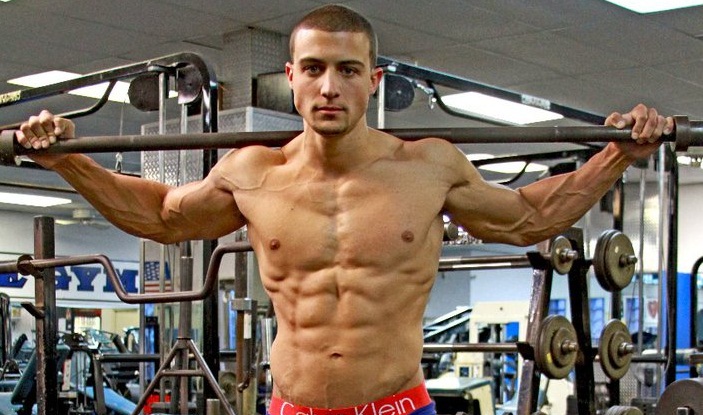
Getting Started
First, determine your current goal. Then, read through the categories to find those that would best serve your needs. No single category will fully serve your goal, no matter what it may be, so mix and match them a bit. Also, keep in mind that eating a variety of foods is always better than relying on a limited selection. The more types of food you eat, the better the range of nutrients you provide your body.
Category 1 Pure Protein
Most of these foods are not “pure” protein, but they are high enough to be thought of as such. For instance, chicken breasts actually score low in this category in terms of percentage of calories from protein, but many bodybuilders rely on them as their number-one source year-round. These foods can be eaten by all bodybuilders at all times. Athletes who are trying to shed bodyfat should get the lion’s share of their protein from sources that are 70% or higher in calories from protein. This allows for some flexibility in overall dietary intake, while still keeping calories low. Bodybuilders trying to gain muscle mass can eat as much of these foods as they want, as long as they consume plenty of calories from other sources.
It’s hard to take in adequate calories for adding muscle if you eat too much lean protein it fills you up. Muscle growth depends not only on protein consumption, but also on total calories consumed.
Category 2 High Protein
These foods are good for adding mass because they offer a generous amount of protein and also contain enough dietary fat to boost the total calorie count. When you’re trying to increase your bodyweight and muscle mass, you need more calories, and the added fat from these foods will tip the calorie equation toward your goal. If you have a fast metabolism and rarely get “sloppy” during a bulking phase, these make some of the best sources of protein for building muscle mass. They’re also excellent choices for hardgainers. This category includes a wide range in percentage of calories from protein. Foods that offer more protein, such as steaks, tend to be more expensive.
Be aware that foods on the lower end of this list are higher in fat more than 70% of the calories in some of them come from fat, much of which is the less-than-healthy saturated variety. For good bodybuilding results, balance these protein sources with those from other categories.
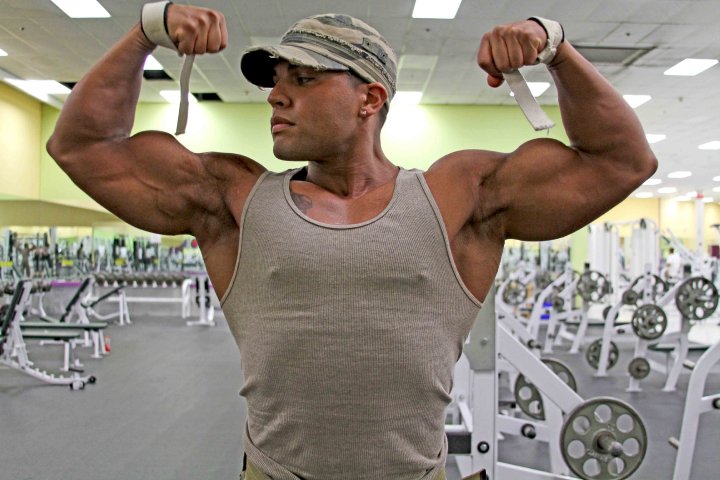
Category 3 Double-Duty Protein
Foods in this category provide plenty of protein and a hefty amount of healthy fats. Although the percentage of calories from protein is less than 20 for some of these foods, they are nonetheless excellent choices for most bodybuilders. Healthy fats, such as omega-3s and omega-6s in these foods, are notoriously deficient in many bodybuilding diets.
Many trainers shy away from items on this list (even whole eggs) because they fear adding bodyfat. In reality, bodybuilders should consume more healthy fats and reduce consumption of processed carbs, such as sugar and bleached flour.
Even if you’re dieting, you can benefit from some of these foods. The omega-3s found in sardines and salmon may help your body store carbohydrates as muscle glycogen. If you’re a dieting bodybuilder and eating relatively few carbs, this can help you replenish glycogen stores and make you less inclined to store bodyfat. Dieting bodybuilders should eat these protein foods three times a week. Eggs serve as a good source of protein for bodybuilders interested in bulking up. Eggs are higher in saturated fat, which is somewhat correlated with testosterone levels. With sufficient dietary fat, testosterone levels remain within a normal range or even elevated. If your diet relies heavily on very low-fat foods, such as those found in the Pure-Protein category, you might be compromising your testosterone levels.
If you tend to stay lean, you can eat whole eggs year-round. If you have a hard time staying lean while bulking up, eat a combination of one or two whole eggs with four or five egg whites; while dieting, use only egg whites for three days, switching to whole eggs every fourth day to help boost your testosterone levels.
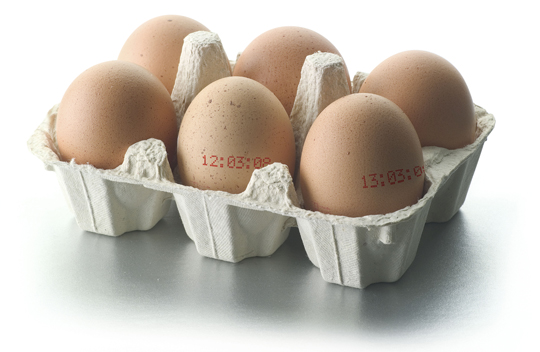
Category 4 Milk Protein
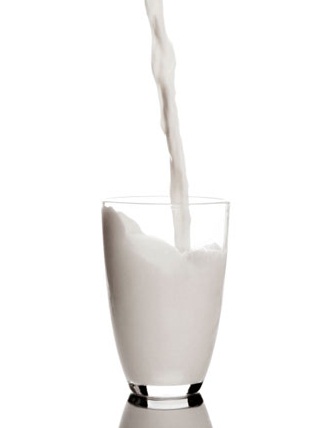 Dieting bodybuilders tend to shun milk products even fat-free cheese, yogurt and skim milk in the belief that consuming these foods will interfere with fat loss. In fact, they may have the opposite effect. Calcium in dairy foods actually triggers hormonal support to facilitate fat loss during a reduced-calorie diet. Bodybuilders ought to incorporate plenty of fat-free dairy products in their cutting strategies. If you’re in a bulking phase, low-fat milk, cheese and yogurt are great choices because they’re not only abundant in protein and calcium, but they also contain conjugated linoleic acid.
Dieting bodybuilders tend to shun milk products even fat-free cheese, yogurt and skim milk in the belief that consuming these foods will interfere with fat loss. In fact, they may have the opposite effect. Calcium in dairy foods actually triggers hormonal support to facilitate fat loss during a reduced-calorie diet. Bodybuilders ought to incorporate plenty of fat-free dairy products in their cutting strategies. If you’re in a bulking phase, low-fat milk, cheese and yogurt are great choices because they’re not only abundant in protein and calcium, but they also contain conjugated linoleic acid.
This substance, found in dairy fat, may help repartition what you eat, funneling calories toward growth and repair rather than toward bodyfat storage.
Category 5 Plant Protein
Unless you’re a vegetarian bodybuilder, you probably don’t turn to vegetables and legumes as a primary source of protein. However, many vegetables do contain the macronutrient, and some have a substantial amount. (Every item on this list contains a higher percentage of calories from protein than whole milk or ground beef!) Not only do these foods contain protein, but many are also high in fiber, if you’re in a bulking phase and experience wide swings in blood-sugar levels in other words, you often feel lousy after eating a large meal consider consuming more beans, peas and lentils. Their high-fiber content tends to slow the digestion of carbohydrates. This may aid you in training and in avoiding blood-sugar “lulls,” helping to keep muscle-wasting hormones in check. That translates to better muscle growth.
Protein Source Graph
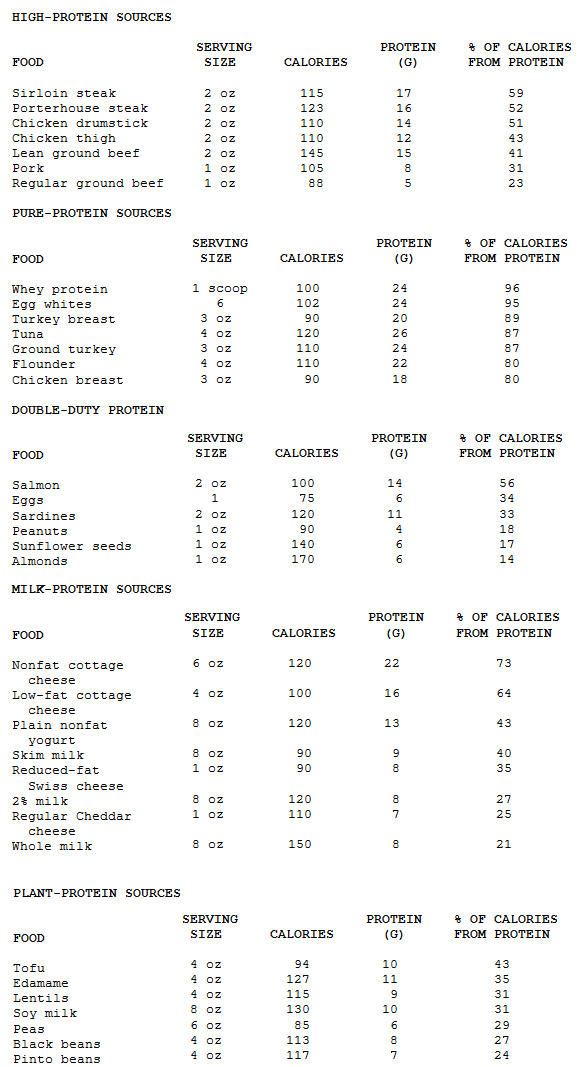
Once you’ve determined your goal, you can mix and match the protein sources that best serve your needs. Growing is about knowing.
Author: Chris Aceto
Websites: Procardnutrition.com & Flexonline.com
Photgraphy By: Jimmy Murtaugh
COPYRIGHT 2010 Weider Publications
COPYRIGHT 2010 Gale, Cengage Learning










